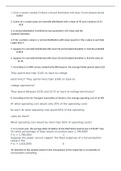Essay
BTEC APPLIED SCIENCE UNIT 9C - DISTINCTION
- Institution
- PEARSON (PEARSON)
Distinction assignment from BTEC Applied Science Unit 9 - human health and reproduction. unit 9C includes the structure and function of reproductive anatomy, and describes how hormones are involved in gamete development and conception. it also explains how the regulation of male and female reproduc...
[Show more]






